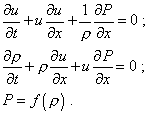SELF |
62 - 66 |
S.B. Karavashkin and O.N. Karavashkina |
|
|
|
SELF |
62 - 66 |
S.B. Karavashkin and O.N. Karavashkina |
|
|
|
62 1. For the sought functions taken as the accounted small values of the first order, all equations, additional relationships like the state equations, relations expressing the initial and boundary conditions etc. are written as linear equations after we neglected the small values of the higher-than-first order. … The sought functions are determined as the solutions of the linear system of equations in the known domain D0 with the linear boundary conditions at the known surface S0” [2, p. 387]. The equation (1) to which, in particular, the Maxwell equations are reduced belongs to the same linearised differential equations. But “Maxwell’s equations are linear for the field in the void; the nonlinearity arises on the account of interaction of the electric field with the medium, with account of complicated Ohm’s law and complicated laws for electric polarisation and magnetisation” [2, p. 386]. But nonlinear progressive waves in the continuum theory, which behave as those shown in Fig. 1 are studied on the physical models with nonlinear parameters. The main of these models are following: 1. The models that account the sound speed dependence on the densification S. The differential equation related to this model has a form [3, p. 335] |
??? - ?????????? ???????? ?????; - ????????? ???????? ?????? ??? ?????????? ???????? ? ??????; - ????? ???????? ????. where c02
= 63 2. The models that account the complicated regularity
between the deformation |
3. The models of non-stationary isentropic flow [6, p. 232- 241], [4, p. 231]. The mathematical model of this process is derived through the system of nonlinear equations of 1D motions of ideal compressible liquid in case of barotropic processes: |
 |
Besides, there is a number of nonlinear models that give us the results comparable with Fig. 1 but take into account the nonlinear characteristics of continua more completely than in the mentioned models. 64 However, with all features of the wave processes, the restriction from the top and bottom of the domain of automodel solutions is the common typical feature of all listed nonlinear models. When the automodelity conditions broken, the wavefront described by the nonlinear models has a limited term of existence and then decays. The distinction of the solution (3) that has been found in the beginning of this paper is the exact opposition of the above features to the adduced nonlinear models. These are namely such: 1. This solution satisfies the second-order linear differential equation (1). 2. The automodelity of this solution is restricted only from the top and only if the solution was one-valued, because of constant speed of wave propagation irrespectively of the deformation parameters. At the same time, the found solution may not and should not be substituted to the nonlinear models, as it is only an intermediate link between the linear and nonlinear domains of behaviour of a wave process considered before as two extreme poles of the same phenomenon with a ‘gap’ between them, because of uncertainty, how these extremes are joined. To finish with, I would like to touch the issue of
standing waves described by the expression (7), when the superposition of equal-amplitude
waves and of the factor the direct wave |
65 and the reverse wave |
As the result, there will form a wave of the kind |
| (7) |
The function (8) has the evident signs of the class of functions describing the standing waves. This corroborates again the correctness of the initial analogy with the progressive waves in continuum. 66 References: 1. Korn, G.A. and Korn, T.M. Mathematical handbook for scientists and engineers. MGraw-hill book company, New York - Toronto - London, 1961; cited after the Russian edition of the same name 2. Sedov, L.I. Mechanics of continuum, vol. 1. Nauka, Moscow, 1973 (Russian) 3. Pain, H.J. The physics of vibrations and waves. John Wiley and sons, London - New York - Sydney - Toronto, 1976; cited after the Russian edition of the same name 4. Sedov, L.I. Mechanics of continuum, vol. 2. Nauka, Moscow, 1973 (Russian) 5. Lokshin, A.A. and Sagomonyan, E.A. The nonlinear waves in mechanics of rigid bodies. Moscow State University Press, 1989 (Russian) 6. Kompaneetz, A.S. The course of theoretical physics, vol. 2. Prosveccenie, Moscow, 1975 (Russian) 1987 |